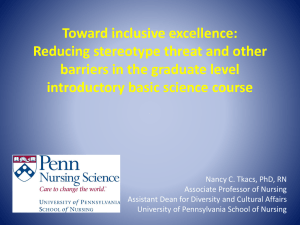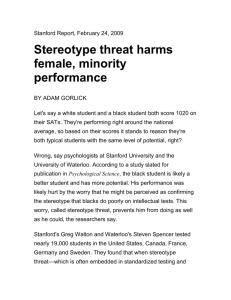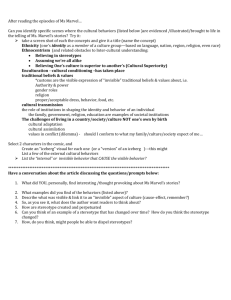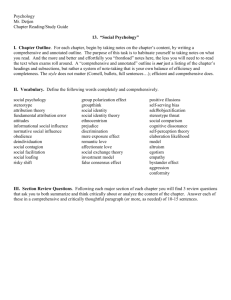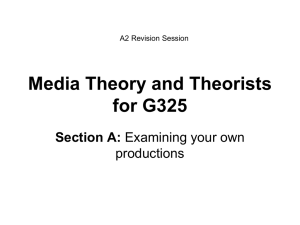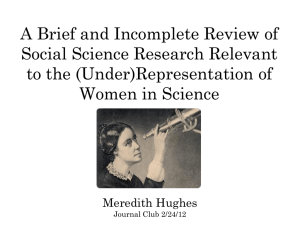1. Stereotype threat affects members of any group about whom there
advertisement
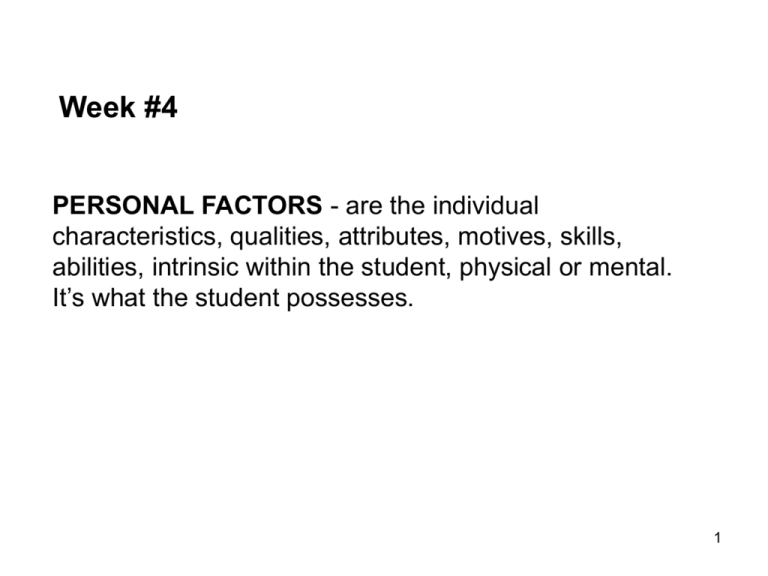
Week #4 PERSONAL FACTORS - are the individual characteristics, qualities, attributes, motives, skills, abilities, intrinsic within the student, physical or mental. It’s what the student possesses. 1 Stereotype Threat is the threat of being viewed through the lens of a negative stereotype or the fear of doing something that would inadvertently confirm that stereotype. According to Claude Steele there are 5 main features of stereotype threat: 1. Stereotype threat affects members of any group about whom there exists some negative stereotype. It has the potential to affect members of any group, if a situation makes them believe they will be viewed in light of a negative stereotype. 2. A stereotype must be relevant to one’s self for it to be threatening; in other words, one must care about the domain or behavior that the stereotype describes. (Domain Identification) 3. Stereotype threat is variable across different groups and situations. Different groups experience different degrees of threat depending on the content of the stereotype and the situation. 4. One need not believe in the stereotype for it to be threatening. 5. Trying to disprove a stereotype—by outperforming for example—has detrimental effects and leads to a decrease in performance 2 In order for Stereotype Threat to occur one must have Domain Identification Example - Students identify with the “Academic” Identification Domain Identification - To make this identification, what is necessary? • I care about the domain, I can identify with it, it’s positive for me • It interests me, it is attractive, provides rewards for me • I can be accepted and valued in that domain, I have a sense of belonging • I have the skill, talent, the ability, I belong • No insurmountable barriers exist to domain entry, adequate opportunity available Stereotype Threat • Arises in a situation in which the stereotype is relevant • The situation strikes one as a test of stereotype-relevant qualities • Arises for people who have made the relevant identifications – they care about doing well • For them, the threat is to their “self-identity” The Theory Stated • When a negative stereotype becomes salient as a criterion for impact • Individual group members become concerned about confirming the stereotype • Through various psychological mechanisms, the concern can cause group members to perform more poorly, than they would performing in a neutral context 3 Research Evidence 1. Women scored worst when test was primed “difficult” and on math than they did on the literature portion of the exam (frustration performance) 2. Is it Genes? - In the study, telling participants that the study was to “show gender differences” made a difference: situational pressure 3. Among African Americans, indicating race affects score, saying it was a test of intellectual ability or lab problem affected scores 4. Stereotypical Word Test: African Americans completed most self-doubt words and disaffiliated w/Black culture 4 Disidentification – offers the retreat of not caring about the domain in relations to self. • But as it protects, it could undermine sustained motivation in the domain – results could be costly when the domain is as important as education • self is protected because it no longer values that domain, doesn’t care, but it can also become problematic by undermining the importance • Inadequacy can become part of the personality and have low expectations for self, de-motivation, and low performance 5 Stereotype Threat affects Confident Students The Best Students are most affected and fare the worst “most achievement oriented students, who were also the most skilled, motivated, and confident were the most impaired by stereotype threat.” Why? – This happens because they identified more with school, trying hard to disconfirm the negative stereotype about their group. They are plagued with a host of threatening distractions, obstacles, self consciousness, test anxiety, loss of motivation – all leading to a dramatic decreases in test performance 6 Strategies: For domain ID and non-domain ID – Optimistic teacher/student relationships – Giving challenging work, but achievable – Stressing expandability of intelligence For domain ID only – Affirm domain belongingness – Value multiple perspectives – Role models For non-domain ID only – Nonjudgmental responses – Build self efficacy 7 A positive personal factor that can enhance academic success-- “Resliency” What is a Resilient student? • Being able to overcome • Despite incredible hardships and the presence of “atrisk” factors, some students have developed characteristics and coping skills that enable them to succeed. • They appear to develop stable, healthy personas and are able to recover from or adapt to life’s stresses and problems. 8 What enables “resilient” students to succeed academically? Elements of Resiliency • Individual Attributes - positive attitudes, high intrinsic motivation, and internal locus of control, strong self efficacy, clear realistic goals, optimistic, do not blame home environment or school • Positive Use of Time – extracurricular activities, sports, hobbies provide a refuge for students, involvement in required helpfulness – volunteer work, community service, • Family Factors - has close bond with at least once caregiver (family composition does not matter) - educational background of parents helpful • School Factors - support in school, extracurricular increases involvement. School staff who have taken a personal interest in student. 9 Profile of a Resilient Student 1. Internal locus of control and healthy internal attributions 2. Take responsibility for their successes and failures and show a strong sense of self-efficacy– “my fault if I don’t do well”, recognize they have to work harder 3. they feel they have been successful because they have chosen to be and credit themselves 4. have positive expectations about their abilities – optimistic, strong sense of hope 5. involved in positive activities, that provide them a sense of support, success and recognition 6. have a trusting relationship with an adult, using one parent 10 Implications: • Teachers should establish reference points where achievement will be identified and relate success to effort • Teachers/counselors need to be trained and encouraged to provide activities to build students’ self-esteem and self-confidence • Extracurricular activities expanded and promoted • Teachers need to be trained and encouraged to develop relationships with at-risk children 11 Two types of motivation: 1. Intrinsic – students undertake an activity for its own sake, for the enjoyment it provides, the learning it permits or the feelings of accomplishment it evokes – advantages of students being intrinsically motivated is they employ strategies that demand more effort and enable them to process information more deeply --- they develop into the critical thinkers, won’t give up so easily when challenged, become the problem solvers; they learn to process information 2. Extrinsic – students perform in order to obtain some reward or avoid some punishment external to the activity itself, like grades, stickers, teacher approval, parent retribution. – disadvantage of extrinsic motivation, it has the potential of decreasing existing intrinsic motivation (students will come to expect something every time they perform (money for A’s on report card) 12 “Learning and Motivation” Motivation is defined as an internal state that arouses, directs and maintains behavior. Motivation is manifested in the classroom by the following behaviors: – choice of behavior, – level of the activity and involvement – persistence of behavior – and regulation of effort. 13 Influences on School learning and motivation are found both inside and outside of the classroom • Social and cultural factors – stds don’t come to classroom as “blank slates”, also what is considered intelligent behavior in one setting may not be viewed as such in another • Classroom Contextual Factors – teachers structure activities, award and interact w/ stds in ways that influence stds personal learning and goals or intentions for performing a task. – Mastery goal is oriented toward learning as much as possible for self-improvement, irrespective of the performance of others – Performance goal focuses on social comparison and competition with the main purpose of outperforming others on the task. 14 TARGET Dimensions that affect motivation in the classroom & instructional changes that can help influence motivation • Task – type of task given can influence different types of motivation, link classroom activities to students’ life experiences • Authority – how much opportunity stds are given to take their own initiative & responsibility for their learning • Recognition dimension concerns with the formal and informal use of rewards • Grouping dimension focus on the ability of students to work effectively with each other (cooperative, competitive, indivi). Should use a variety of grouping • Evaluation – type and frequency of evaluation can have an impact on std motivation. Should reduce social comparison and competition in the classroom • Time Dimension – concerns the appropriateness of the task, the pace of instruction and the time allotted for completing learning activities and assignments. 15 Internal Factors • Value Component – Why am I doing this task? - A student’s goal orientation may guide the general direction of the behavior whereas “Value” may influence the strength or intensity of the behavior. – In general individuals tend to be become involved in tasks that they positively “value” and avoid tasks that they negatively value • Expectant Component: Can I do this task? – – Self Efficacy Beliefs (can do belief, I have the ability), – Control Belief (can do, but can’t control the outcome), – Attribution Beliefs (explanations for causes of their successes or failures) • • • • ability (good/bad in math), effort (studied/didn’t study), task difficulty (easy/hard test), luck (guessed right/wrong) • Affective Component: How Do I feel about the Task? – Anxiety (affects student’s emotional state), Covington’s Self-Worth Theory (one is valued because of accomplishments will use procrastination, unattainable goals or underachiever to protect any inferences to a lack of ability) 16 Student Self-Regulation Strategies Self-Talk – the running dialogue inside our heads. What we say to ourselves is an important factor in determining our attitudes, feelings, emotions, and behavior. EXAMPLE – the little engine that could. SELF-TALK help us to try new tasks, to persist in difficult situations, can also be unproductive when it is negative. How can we change negative self talk? Goal Setting – establishing specific goals helps to direct attention to tasks, mobilize effort, increase persistence, and promote the use of new strategies when old ones stop working Concentration & Attention skills that are critical in school: 1) identification of important text elements, 2) comprehension monitoring, 3) sustained attention on tasks (persistence – important for stds to deal with internal and external distractions.) Time Management –dealing more with making the right choices about how you’ll use your time is more important that doing an efficient job, effectiveness more important Procrastination – is a complex problem with no simple solution, there are diff types of academic procrastination, no one treatment can be effective with all stds. Students must seek out the causes for the procrastination and change attitude implement changes. 17
